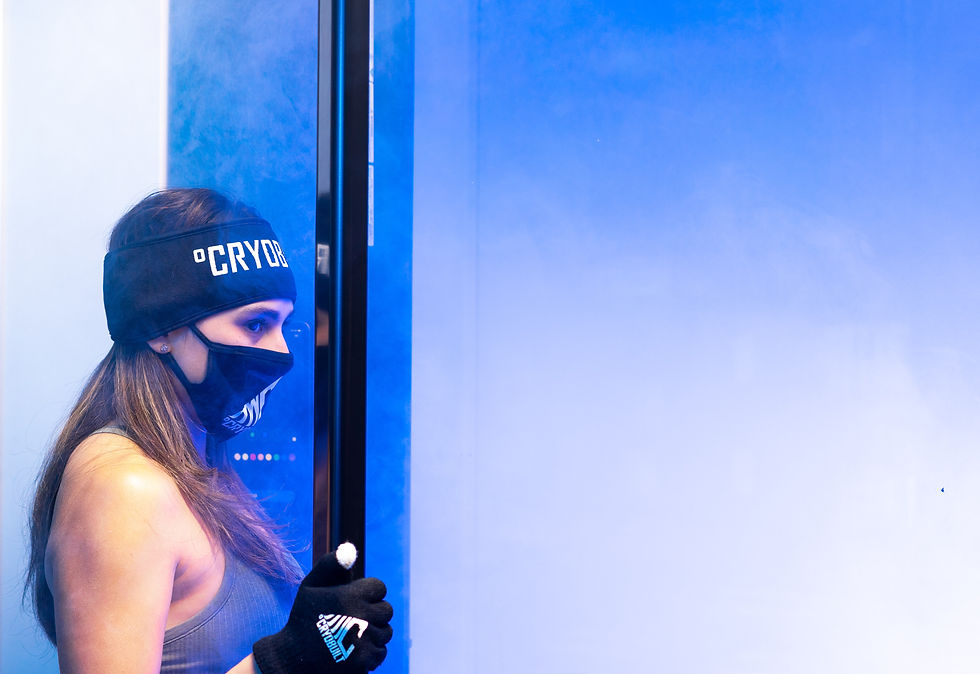What is Cryotherapy?
- rearegan91
- Feb 19
- 4 min read

Cryotherapy, the practice of exposing the body to extremely cold temperatures, has gained popularity in recent years as a potential tool for recovery and performance enhancement.
While it may seem counterintuitive to subject yourself to such frigid conditions, there is growing evidence to suggest that cryotherapy can offer a range of benefits.
In this article, we'll delve into what cryotherapy is, how it works, and how you can incorporate it into your fitness journey.
What is Cryotherapy?
Cryotherapy involves exposing the body to extremely cold temperatures, typically between -100°C and -200°C, for a short period of time. This exposure can be achieved through whole-body cryotherapy (WBC), where the entire body is submerged in a cryotherapy chamber, or localized cryotherapy, where only specific areas of the body are exposed to cold temperatures using devices like ice packs or cold therapy machines.
How Does Cryotherapy Work?
The exact mechanisms by which cryotherapy works are not fully understood, but several theories have been proposed. One theory suggests that the cold temperatures cause vasoconstriction or narrowing of the blood vessels. This constriction reduces blood flow to the affected area, potentially reducing inflammation and pain. When the body is warmed up, the blood vessels dilate, increasing blood flow and promoting healing.
Another theory suggests that cryotherapy can activate the body's stress response, leading to the release of endorphins and other hormones that can have mood-boosting and pain-relieving effects. Additionally, some studies have shown that cryotherapy can improve muscle function and reduce muscle soreness after exercise.
5 Benefits of Cryotherapy
1. Pain Relief
Cryotherapy has been shown to be effective in reducing pain associated with conditions like arthritis, muscle strains, and sports injuries. The extreme cold of cryotherapy constricts blood vessels, effectively reducing inflammation in sore or injured muscles. Following treatment, as the body rewarms, blood flow increases, aiding in the removal of toxins and the delivery of essential nutrients to the muscles.
Consequently, many athletes experience a decrease in delayed onset muscle soreness (DOMS) after strenuous workouts when incorporating cryotherapy into their recovery routine.
2. Reduced Inflammation
The vasoconstriction caused by cryotherapy can help reduce inflammation, which can promote healing and reduce pain. Additionally, cold exposure stimulates the body to produce more white blood cells, which can strengthen the immune system. Furthermore, cryotherapy has been shown to decrease oxidative stress in the body, a factor that can contribute to improved overall health.
3. Improved Recovery
Cryotherapy may help athletes recover more quickly from intense workouts or competitions by reducing muscle soreness and inflammation. Cryotherapy can lead to increased energy levels by triggering the release of endorphins and norepinephrine, providing a natural energy boost.
Many athletes also report improved mental clarity and focus following cryotherapy sessions. Additionally, regular treatments may contribute to better sleep quality by helping to regulate sleep patterns, ensuring individuals are well-rested for optimal performance.
4. Enhanced Performance
Some studies have suggested that cryotherapy can improve athletic performance by increasing muscle power and reducing fatigue. Additionally, it is recommended that an athlete should utilize cryotherapy about three hours before a competition as this can help improve athletic performance. If this isn’t possible then some studies show that post-exercise cold exposure can also help reduce perceived muscle soreness after training. So it’s best to try both to see which works best to help with enhanced performance.
5. Mood Boost
The release of endorphins and other hormones triggered by cryotherapy can have a positive impact on mood and reduce stress.
Incorporating Cryotherapy into Your Fitness Journey
If you're interested in trying cryotherapy, it's important to consult with a healthcare professional to determine if it's right for you. Here are some tips for incorporating cryotherapy into your fitness journey:
Start Gradually: If you're new to cryotherapy, start with shorter sessions and gradually increase the duration as your body adapts.
Listen to Your Body: Pay attention to your body's signals. If you experience any discomfort or adverse effects, stop the session immediately.
Combine with Other Therapies: Cryotherapy can be used in conjunction with other therapies, such as massage or physical therapy, to enhance recovery and performance.
Consider Your Goals: Determine whether your goals are related to pain relief, recovery, or performance enhancement. This will help you tailor your cryotherapy sessions accordingly.
Safety Considerations of Cryotherapy
While cryotherapy is generally considered safe, it's important to be aware of the potential risks. These include frostbite, which can occur if the skin is exposed to extremely cold temperatures for too long.
It's also important to avoid cryotherapy if you have certain medical conditions, such as Raynaud's disease or peripheral vascular disease.
Is Cryotherapy Right For You?
In conclusion, cryotherapy offers a range of potential benefits for athletes and individuals seeking pain relief and improved recovery. While more research is needed to fully understand its mechanisms of action, the available evidence suggests that cryotherapy can be a valuable tool for enhancing fitness and well-being.
If you're considering trying cryotherapy, it's important to consult with a healthcare professional and start gradually to minimize the risks and maximize the benefits.



